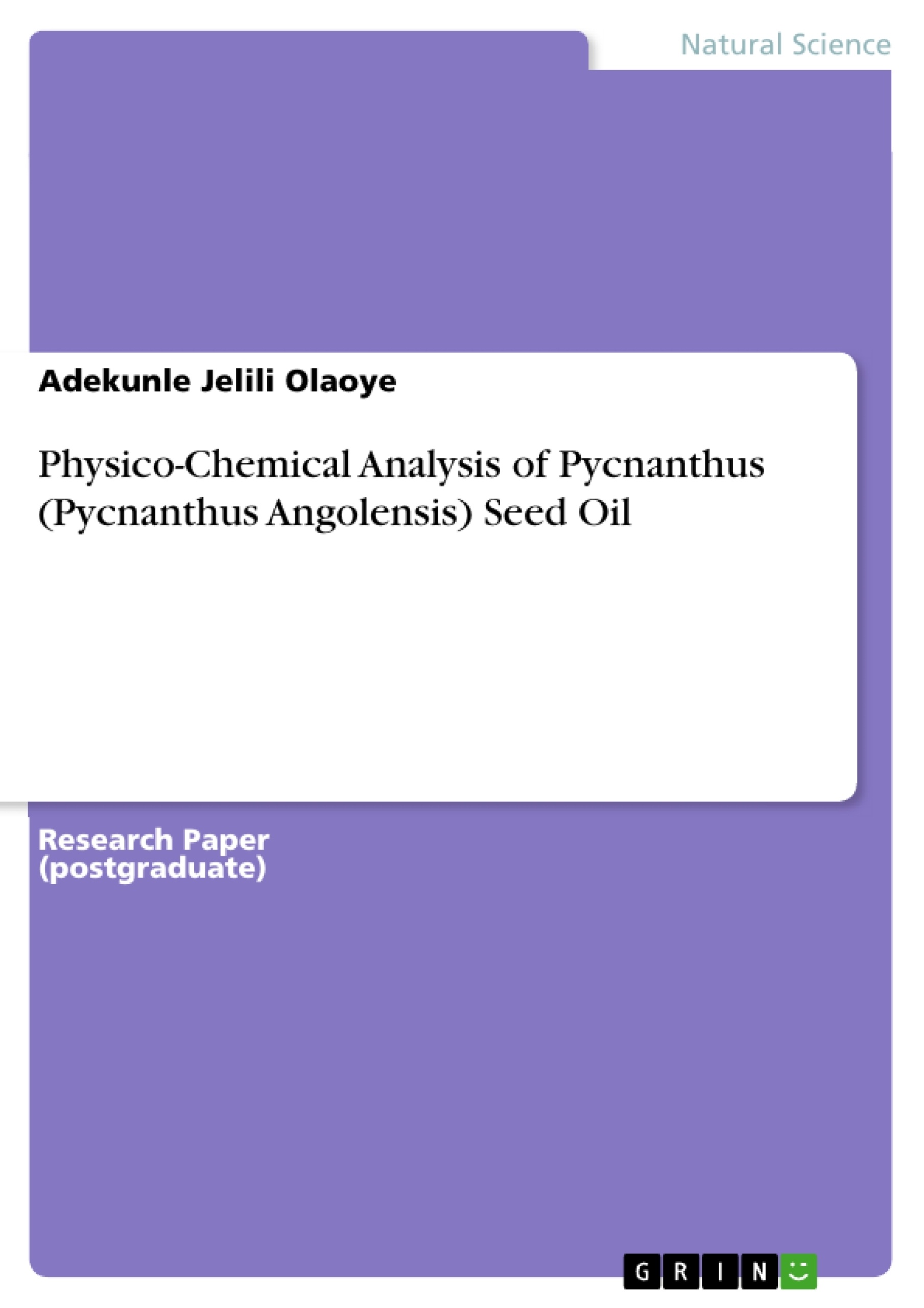This study was based on physico-chemical analysis of the oil content of Pycnanthus seed for its potential and industrial uses. Seeds were collected from a Pycnanthus tree at Awba-dam, UI Ibadan. The results obtained are oil extract 48%, the specific gravity 0.978, refractive index 1.4521, melting point 500C, the saponification value 245.44%, acid value 6.21mg(OH)/g oil, peroxide value 16.12mEq/kg and ester value 239.23. The iodine value of seed oil which placed the oil in the non-drying group was 84.94. Fatty acid composition of the seed oil showed the oil to be rich in lauric acid 64.72%, palmitic acid 13.97%, capric acid 4.99%, capryclic acid 4.40%, myristic acid 4.33% and stearic acid 1.93%. It also contained oleic acid 3.26% and linoleic acid 2.40%. The other fatty acids present in the oil are palmitoleic acid, Linolenic acid and Llignoceric acid. The seeds of the plant could be a source of industrial raw material.
Inhaltsverzeichnis (Table of Contents)
- INTRODUCTION – PYCNANTHUS ANGOLENSIS
- FUNCTIONAL USES
- MATERIALS AND METHODOLOGY
- SAMPLE COLLECTION
- SAMPLE PREPARATION
- DETERMINATION OF PHYSICAL AND CHEMICAL PROPERTIES OF PYCNANTHUS SEED OIL
- CRUDE FAT DETERMINATION
- SOLVENT SELECTION
- EXTRACTION METHOD
- BATCH SOLVENT EXTRACTION
- RESULT AND DISCUSSION
- REFERENCES
Zielsetzung und Themenschwerpunkte (Objectives and Key Themes)
This study aims to analyze the physicochemical properties of oil extracted from Pycnanthus angolesis seeds, exploring its potential for industrial applications.
- Physicochemical properties of Pycnanthus angolesis seed oil
- Industrial uses of Pycnanthus angolesis seed oil
- Fatty acid composition of Pycnanthus angolesis seed oil
- Potential of Pycnanthus angolesis seed as an industrial raw material
- Traditional and medicinal uses of Pycnanthus angolesis
Zusammenfassung der Kapitel (Chapter Summaries)
- INTRODUCTION – PYCNANTHUS ANGOLENSIS: This chapter provides a detailed introduction to the Pycnanthus angolesis tree, commonly known as African nutmeg. It discusses the botanical classification, common names, and various medicinal uses of different parts of the plant. The chapter also describes the physical characteristics of the tree, its fruits, and its distribution across various African countries.
- FUNCTIONAL USES: This chapter outlines the diverse functions of Pycnanthus angolesis. It highlights its use as fuel, the extraction of oil for soap making, and its medicinal applications, including treatments for toothache, poisoning, and stomachache. The chapter also discusses its use as timber and its various applications in carpentry and construction.
- MATERIALS AND METHODOLOGY: This chapter details the materials used and the methodology employed in the study. It outlines the process of collecting, preparing, and extracting the oil from Pycnanthus angolesis seeds. The chapter also describes the methods used to determine the physicochemical properties of the oil, including specific gravity, saponification value, acid value, iodine value, and refractive index.
Schlüsselwörter (Keywords)
The primary focus of this research is on the physicochemical analysis of Pycnanthus angolesis seed oil, including specific gravity, iodine value, refractive index, and fatty acid composition. The study explores the potential of this oil for various industrial applications and highlights its significance as a potential source of industrial raw materials.
- Arbeit zitieren
- Adekunle Jelili Olaoye (Autor:in), 2017, Physico-Chemical Analysis of Pycnanthus (Pycnanthus Angolensis) Seed Oil, München, GRIN Verlag, https://www.hausarbeiten.de/document/354931


